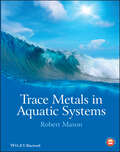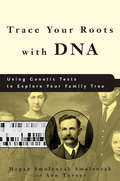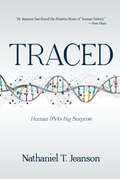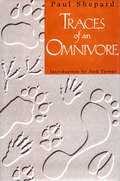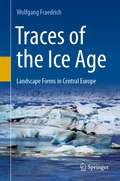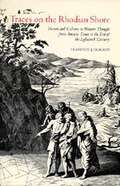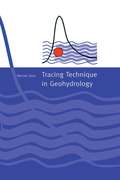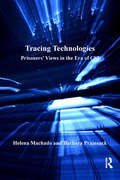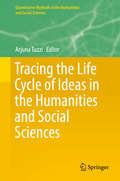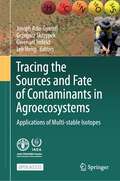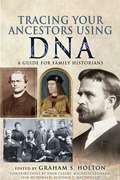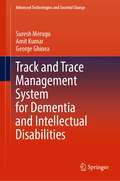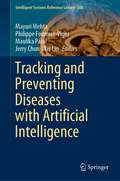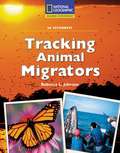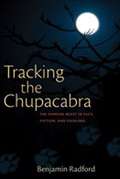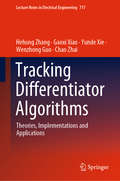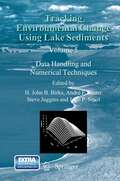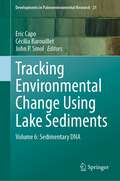- Table View
- List View
Trace Metals in Aquatic Systems
by Robert P. MasonThis book provides a detailed examination of the concentration, form and cycling of trace metals and metalloids through the aquatic biosphere, and has sections dealing with the atmosphere, the ocean, lakes and rivers. It discusses exchanges at the water interface (air/water and sediment/water) and the major drivers of the cycling, concentration and form of trace metals in aquatic systems. The initial chapters focus on the fundamental principles and modelling approaches needed to understand metal concentration, speciation and fate in the aquatic environment, while the later chapters focus on specific environments, with case studies and research highlights. Specific examples deal with metals that are of particular scientific interest, such as mercury, iron, arsenic and zinc, and the book deals with both pollutant and required (nutrient) metals and metalloids. The underlying chemical principles controlling toxicity and bioavailability of these elements to microorganisms and to the aquatic food chain are also discussed. Readership: Graduate students studying environmental chemistry and related topics, as well as scientists and managers interested in the cycling of trace substances in aqueous systems Additional resources for this book can be found at: www.wiley.com/go/mason/tracemetals.
Trace Quantitative Analysis by Mass Spectrometry
by Robert A. Bethem Cecilia Basic Robert K. BoydThis book provides a serious introduction to the subject of mass spectrometry, providing the reader with the tools and information to be well prepared to perform such demanding work in a real-life laboratory. This essential tool bridges several subjects and many disciplines including pharmaceutical, environmental and biomedical analysis that are utilizing mass spectrometry:Covers all aspects of the use of mass spectrometry for quantitation purposesWritten in textbook style to facilitate understanding of this topicPresents fundamentals and real-world examples in a 'learning-though-doing' style
Trace Your Roots with DNA: Using Genetic Tests to Explore Your Family Tree
by Ann Turner Megan Smolenyak SmolenyakWritten by two of the country's top genealogists, Trace Your Roots with DNA is the first book to explain how new and groundbreaking genetic testing can help you research your ancestryAccording to American Demographics, 113 million Americans have begun to trace their roots, making genealogy the second most popular hobby in the country (after gardening). Enthusiasts clamor for new information from dozens of subscription-based websites, email newsletters, and magazines devoted to the subject. For these eager roots-seekers looking to take their searches to the next level, DNA testing is the answer. After a brief introduction to genealogy and genetics fundamentals, the authors explain the types of available testing, what kind of information the tests can provide, how to interpret the results, and how the tests work (it doesn't involve digging up your dead relatives). It's in expensive, easy to do, and the results are accurate: It's as simple as swabbing the inside of your cheek and popping a sample in the mail. Family lore has it that a branch of our family emigrated to Argentina and now I've found some people there with our name. Can testing tell us whether we're from the same family?My mother was adopted and doesn't know her ethnicity. Are there any tests available to help her learn about her heritage? I just discovered someone else with my highly unusual surname. How can we find out if we have a common ancestor? These are just a few of the types of genealogical scenarios readers can pursue. The authors reveal exactly what is possible-and what is not possible-with genetic testing. They include case studies of both famous historial mysteries and examples of ordinary folks whose exploration of genetic genealogy has enabled them to trace their roots.
Traceability, Validation and Measurement Uncertainty in Chemistry: Practical Examples
by Nineta Hrastelj Ricardo Bettencourt da SilvaThis book presents worked examples of five analytical procedures. These practical examples address traceability, validation and measurement uncertainty aspects in a systematic and consistent way, and cover applications in the analysis of water, food, as well as ores and minerals. This concept is based on the experiences of the TrainMiCc program, in which more than 9000 laboratory professionals all over Europe have participated.
Traced: Human DNA's Big Surprise
by Nathaniel JeansonWhat happened to the ancient Egyptians? The Persians? The Romans? The Mayans? ARE WE THEIR DESCENDANTS? Recent genetic discoveries are uncovering surprising links between us and the peoples of old—links that rewrite race, ethnicity, and human history. Today’s Native Americans descend from Central Asians who arrived in the early A.D. era. Abraham, Isaac, and Jacob still have clearly identifiable descendants, albeit rare ones. Every people group on earth can genetically trace their origins to Noah and his three sons.
Tracer Hydrology 97
by A. KranjcThis collection of papers is the proceedings of the 7th International Synosium on Water Tracing in Portoroz/Slovenia from 26-31 May 1997. They address a number of topics in hydrology tracing techniques including: protection of natural resources against pollution; the use of natural and artificial tracers to help to assess contaminant transport in surface waters; and aquifer parameters and modelling.
Tracer Technology
by Octave LevenspielThe tracer method was first introduced to measure the actual flow of fluid in a vessel, and then to develop a suitable model to represent this flow. Such models are used to follow the flow of fluid in chemical reactors and other process units, in rivers and streams, and through soils and porous structures. Also, in medicine they are used to study the flow of chemicals, harmful or not, in the blood streams of animals and man. Tracer Technology, written by Octave Levenspiel, shows how we use tracers to follow the flow of fluids and then we develop a variety of models to represent these flows. This activity is called tracer technology.
Traces of an Omnivore
by Jack Turner Paul ShepardPaul Shepard is one of the most profound and original thinkers of our time. He has helped define the field of human ecology, and has played a vital role in the development of what have come to be known as environmental philosophy, ecophilosophy, and deep ecology -- new ways of thinking about human-environment interactions that ultimately hold great promise for healing the bonds between humans and the natural world. Traces of an Omnivore presents a readable and accessible introduction to this seminal thinker and writer. Throughout his long and distinguished career, Paul Shepard has addressed the most fundamental question of life: Who are we? An oft-repeated theme of his writing is what he sees as the central fact of our existence: that our genetic heritage, formed by three million years of hunting and gathering remains essentially unchanged. Shepard argues that this, "our wild Pleistocene genome," influences everything from human neurology and ontogeny to our pathologies, social structure, myths, and cosmology. While Shepard's writings travel widely across the intellectual landscape, exploring topics as diverse as aesthetics, the bear, hunting, perception, agriculture, human ontogeny, history, animal rights, domestication, post-modern deconstruction, tourism, vegetarianism, the iconography of animals, the Hudson River school of painters, human ecology, theoretical psychology, and metaphysics, the fundamental importance of our genetic makeup is the predominant theme of this collection. As Jack Turner states in an eloquent and enlightening introduction, the essays gathered here "address controversy with an intellectual courage uncommon in an age that exults the relativist, the skeptic, and the cynic. Perused with care they will reward the reader with a deepened appreciation of what we so casually denigrate as primitive life -- the only life we have in the only world we will ever know."
Traces of Common Xylophagous Insects in Wood: Atlas of Identification - Western Europe
by Magali Toriti Aline Durand Fabien FohrerThis atlas presents a concrete tool to identify xylophagous activity by the remains they left in wooded areas in Western Europe. Xylophagous insects are among the largest predators of woody tissues. They leave discriminating traces, different for each species according to their bioecology, and so it is necessary to know how to recognize and characterize them. The book is a practical tool to help identify and interpret them through a standardized presentation of the most ubiquitous families and a key to their determination. It presents descriptions of the galleries and of morphometry of the faecal pellets based on macroscopic features for xylophagous identification, and includes information about the origin and distribution of the xylophagous biological cycles, bioclimatic conditions and bioecology, and the type of woods that are attacked. The book will be a useful guide for forest managers, heritage conservationists, environmental engineers, bioarchaeologists, entomologists, loggers, and wood anatomists.
Traces of the Ice Age: Landscape Forms in Central Europe
by Wolfgang FraedrichAt present, we have been living in an ice age for around 2.5 million years, a geological epoch in which there is ice on Earth and in which the curve of the global mean temperature is subject to significant fluctuations (current trend: temperature increase). At nearly 16 million square kilometers, about ten percent of the land surface is currently covered by glacial ice-and glacial ice plays a major role in shaping landscapes. This compact textbook sharpens the eye for such landscapes. It makes the forms and the shaping processes comprehensible, which the author illustrates with numerous regional examples, especially from Central Europe, such as the North German Plain and the Alpine foothills, but also from Iceland. What traces have the glaciers and their meltwaters left behind? What formation processes can be inferred? How can recent climate history, in particular that of the Ice Age, be reconstructed? It is exciting to look at current developments in glaciated areas and also to take a look at the (climate) future of the Earth. For example, the question arises as to what influence glaciers have on sea level and on future climate change. In this context, natural processes such as the ice age cycles, for which there are various ice age formation hypotheses, and anthropogenic influences in global warming must be weighed against each other.
Traces on the Rhodian Shore: Nature and Culture in Western Thought from Ancient Times to the End of the Eighteenth Century, First Edition
by Clarence J. GlackenFrom the time of the Greeks to our own, answers to these questions have been and are being given so frequently and so continually that we may restate them in the form of general ideas: the idea of a designed earth; the idea of environmental influence; and the idea of man as a geographic agent. first owes much to mythology, theology, and philosophy; the second, to pharmaceutical lore, medicine, and weather observation; the third, to the plans, activities, and skills of everyday life such as cultivation, carpentry, and weaving.
Tracing Technique in Geohydrology
by Werner KassThis translation of the original German textbook, Hydrogeologie, summarizes tracing techniques. Individual chapters have been contributed by relevant experts from geology, hydrology, chemistry and virology, and engineering and isotope specialists. Text contributions are complemented by numerous figures. A cd rom will assist in the evaluation and presentation of data from tracing tests.
Tracing Technologies: Prisoners' Views in the Era of CSI
by Barbara Prainsack Helena MachadoThe real heroes of television crime shows in the twenty-first century are no longer police detectives but forensic technologies. The immense popularity of high-tech crime television shows has changed the way in which crime scene work is viewed. The term 'CSI-effect' was coined to signify a situation where people's views and practices have been influenced by such media representations, e.g. judges and jurors putting more weight on forensic evidence that has been produced with high-tech tools - in particular, DNA evidence - than on other kinds of evidence. While considerable scholarly attention has been paid to examining the CSI effect on publics, jurors, judges, and police investigators, prisoners' views on forensic technologies and policing have been under-explored. Drawing on a research sample of over 50 interviews carried out with prisoners in Portugal and Austria, this groundbreaking book shows how prisoners view crime scene traces, how they understand crime scene technologies, and what effect they attribute to the existence of large police databases on their own lives, careers, and futures. Through critically engaging with STS, sociological and criminological perspectives on the use of DNA technologies within the criminal justice system, this work provides the reader with valuable insights into the effect of different legal, political, discursive, and historical configurations on how crime scene technologies are utilized by the police and related to by convicted offenders.
Tracing the Life Cycle of Ideas in the Humanities and Social Sciences: A Portrait Of A Discipline Through Analyses Of Scientific Literature (Quantitative Methods in the Humanities and Social Sciences)
by Arjuna TuzziThis book demonstrates how quantitative methods for text analysis can successfully combine with qualitative methods in the study of different disciplines of the Humanities and Social Sciences (HSS). The book focuses on learning about the evolution of ideas of HSS disciplines through a distant reading of the contents conveyed by scientific literature, in order to retrieve the most relevant topics being debated over time. Quantitative methods, statistical techniques and software packages are used to identify and study the main subject matters of a discipline from raw textual data, both in the past and today. The book also deals with the concept of quality of life of words and aims to foster a discussion about the life cycle of scientific ideas. Textual data retrieved from large corpora pose interesting challenges for any data analysis method and today represent a growing area of research in many fields. New problems emerge from the growing availability of large databases and new methods are needed to retrieve significant information from those large information sources. This book can be used to explain how quantitative methods can be part of the research instrumentation and the "toolbox" of scholars of Humanities and Social Sciences. The book contains numerous examples and a description of the main methods in use, with references to literature and available software. Most of the chapters of the book have been written in a non-technical language for HSS researchers without mathematical, computer or statistical backgrounds.
Tracing the Sources and Fate of Contaminants in Agroecosystems: Applications of Multi-stable Isotopes
by Lee Heng Joseph Adu-Gyamfi Grzegorz Skrzypek Gwenaël ImfeldThe objective of this open access book is to present protocols, methodologies, and standard operating procedures (SOPs) used for the identification of sources, transport, and fate of agro-contaminants and illustrate them with several case studies of successful applications. The Soil and Water Management & Crop Nutrition (SWMCN) Subprogramme of the Joint Food and Agriculture Organization (FAO)/International Atomic Energy Agency (IAEA) Centre of Nuclear Techniques in Food and Agriculture, through a Coordinated Research Project (CRP) in partnership with national and international research institutes, developed and evaluated a set of analytical techniques (the toolbox). The toolbox integrates multiple isotope tracers that provide information on the origins and pathways of multiple pollutants through agro-ecosystems, thereby providing more accurate guidance on mitigations. However, land management strategies to address and control the transport of pollutants from soil to water bodies remain the shared responsibility of farm and aquaculture operators, agro-chemical manufacturers, and policymakers in food and agriculture as well as the mining sectors. This book is structured into eight chapters covering (i) an overview of the book’s content, (ii) guidelines for designing water sampling programmes, (iii) the use of mixing models applicable to tracers for water pollution studies, (iv) compound-specific isotope analyses to investigate pesticide degradation in agricultural catchments, (v) the use of stable oxygen isotope composition of phosphate to investigate phosphorous in soil-plant continuum, (vi) the use of stable sulphur isotopes to disentangle agro-pollutants from other contaminants, (vii) nuclear tools used in sediment source apportionment, and (viii) the conclusions and perspectives forward. The book offers up-to-date information, and we hope it is a great source of information for students, researchers, and policymakers. The SWMCN subprogramme thanks all the contributors involved in the preparation of this publication.
Tracing Your Air Force Ancestors: A Guide For Family Historians (Tracing Your Ancestors)
by Phil TomaselliWhether you are interested in the career of an individual air-man or woman, researching medals awarded to a pilot or crew member or just want to know more about a particular squadron or operation, this book will point you in the right direction. Assuming that the reader has no prior knowledge of the air force, its history or organization, Phil Tomaselli explains which records survive, where they can be found and how they can help you in your research. He also recommends resources available online as well as books and memoirs. Each era in air force history is described, from the pioneering days of early aviation and the formation of the Royal Flying Corps in the First World War to the creation of the Royal Air Force, its operations during the Second World War and its postwar development. The author explains the evolving organization of the air force in each period. He also provides pointers and examples which should help researchers find the records of units and bases that individuals served in.
Tracing Your Ancestors Using DNA: A Guide for Family Historians (Tracing Your Ancestors Ser.)
by Graham S. HoltonAn easy-to-use, straightforward guide for British family historians looking to trace their ancestry using DNA testing. DNA research is one of the most rapidly advancing areas in modern science, and the practical use of DNA testing in genealogy is one of its most exciting applications. Yet there is no recent British publication in this field. That is why this accessible, wide-ranging introduction is so valuable. It offers a clear, practical way into the subject, explaining the scientific discoveries and techniques and illustrating with case studies how it can be used by genealogists to gain an insight into their ancestry. The subject is complex and perhaps difficult for traditional genealogists to understand but, with the aid of this book, novices who are keen to take advantage of it will be able to interpret test results and use them to help answer genealogical questions which cannot be answered by documentary evidence alone. It will also appeal to those with some experience in the field because it places the practical application of genetic genealogy within a wider context, highlighting its role as a genealogical tool and suggesting how it can be made more effective.
Track and Trace Management System for Dementia and Intellectual Disabilities (Advanced Technologies and Societal Change)
by Suresh Merugu Amit Kumar George GhineaThis book reviews humanitarian literature and presents the development of low-cost track & trace management system integrated with accurate GPS location data pinging using Internet of Things (IoT). The first part relates to mobile device configuration with an embedded GPS and wireless Internet connection to transmit its current location. The second part presents web server implementation and development that receives the data, parses it, and stores it for access over the Internet. The third part discusses the user interface that allows one to visually identify the current location of the device.
Tracking and Preventing Diseases with Artificial Intelligence (Intelligent Systems Reference Library #206)
by Mayuri Mehta Philippe Fournier-Viger Maulika Patel Jerry Chun-Wei LinThis book presents an overview of how machine learning and data mining techniques are used for tracking and preventing diseases. It covers several aspects such as stress level identification of a person from his/her speech, automatic diagnosis of disease from X-ray images, intelligent diagnosis of Glaucoma from clinical eye examination data, prediction of protein-coding genes from big genome data, disease detection through microscopic analysis of blood cells, information retrieval from electronic medical record using named entity recognition approaches, and prediction of drug-target interactions.The book is suitable for computer scientists having a bachelor degree in computer science. The book is an ideal resource as a reference book for teaching a graduate course on AI for Medicine or AI for Health care. Researchers working in the multidisciplinary areas use this book to discover the current developments. Besides its use in academia, this book provides enough details about the state-of-the-art algorithms addressing various biomedical domains, so that it could be used by industry practitioners who want to implement AI techniques to analyze the diseases. Medical institutions use this book as reference material and give tutorials to medical experts on how the advanced AI and ML techniques contribute to the diagnosis and prediction of the diseases.
Tracking Animal Migrators: National Geographic On Assignment
by Rebecca L. JohnsonHow do butterflies find their way as they migrate thousands of miles each year? See how scientists track and learn more about birds, whales, and butterflies that migrate.
Tracking The Chupacabra: The Vampire Beast In Fact, Fiction, And Folklore
by Benjamin RadfordAmong the monsters said to roam the world's jungles and desolate deserts, none is more feared than the chupacabra---the blood-sucking beast blamed for the mysterious deaths of thousands of animals since the 1990s. To some it is a joke; to many it is a very real threat and even a harbinger of the apocalypse. Originating in Latin America yet known worldwide, the chupacabra is a contradictory and bizarre blend of vampire and shapeshifter, changing its appearance and characteristics depending on when and where it is seen. Rooted in conspiracy theory and anti-American sentiment, the beast is said to be the result of Frankenstein-like secret U.S. government experiments in the Puerto Rican jungles. <P><P>Combining five years of careful investigation (including information from eyewitness accounts, field research, and forensic analysis) with a close study of the creature's cultural and folkloric significance, Radford's book is the first to fully explore and try to solve the decades-old mystery of the chupacabra. Combining five years of careful investigation (including information from eyewitness accounts, field research, and forensic analysis) with a close study of the creature's cultural and folkloric significance, Radford's book is the first to fully explore and try to solve the decades-old mystery of the chupacabra.
Tracking Differentiator Algorithms: Theories, Implementations and Applications (Lecture Notes in Electrical Engineering #717)
by Hehong Zhang Gaoxi Xiao Yunde Xie Wenzhong Guo Chao ZhaiThis book highlights designs, implementations and applications of tracking differentiator (TD) algorithms. The real-time differentiation estimation of a given signal is of high importance in control science and engineering. A good differentiator shall have i) robustness against input noises and ii) exactness with a small phase delay. The book has three focuses:Designing practical, accurate and efficient TD based on discrete-time optimal control (DTOC).Presenting full convergence analysis on DTOC-TDs.Implementing the DTOC-TDs in state estimations in power systems and signal processing, as well as feedback control in maglev train.The proposed TD solution and its successful real-life applications shall stimulate wide interests in different areas including power systems, railway transportations and aerospace industry, etc.
Tracking Environmental Change Using Lake Sediments
by H. John Birks Steve Juggins John P. Smol André F. LotterNumerical and statistical methods have rapidly become part of a palaeolimnologist's tool-kit. They are used to explore and summarise complex data, reconstruct past environmental variables from fossil assemblages, and test competing hypotheses about the causes of observed changes in lake biota through history. This book brings together a wide array of numerical and statistical techniques currently available for use in palaeolimnology and other branches of palaeoecology. Visit http://extras.springer.com the Springer's Extras website to view data-sets, figures, software, and R scripts used or mentioned in this book.
Tracking Environmental Change Using Lake Sediments: Volume 6: Sedimentary DNA (Developments in Paleoenvironmental Research #21)
by Eric Capo Cécilia Barouillet John P. SmolThis book, entitled Tracking Environmental Change Using Lake Sediments: Volume 6 – Sedimentary DNA, provides an overview of the applications of sedimentary DNA-based approaches to paleolimnological studies. These approaches have shown considerable potential in providing information about the long-term changes of overall biodiversity in lakes and their watersheds in response to natural and anthropogenic changes, as well as tracking human migrations over the last thousands of years.Although the first studies investigating the preservation of these molecular proxies in sediments originate from the late-1990s, the number of scientific publications on this topic has increased greatly over the last five years. Alongside numerous ecological findings, several sedimentary DNA studies have been dedicated to understanding the reliability of this approach to reconstruct past ecosystem changes. Despite the major surge of interest, a comprehensive compilation of sedimentary DNA approaches and applications has yet to be attempted. The overall aim of this DPER volume is to fill this knowledge gap.
Tracking Solar Concentrators
by Zafrullah JagooHarnessing a multitude of complementary green energy sources is the only plausible way to satisfy the energy demands of a greedy global economy. The potential of solar energy (being the most abundant) in fulfilling part of the energy requirements of mankind is immense and constitutes the focal point of this book. A self-powered solar tracker that points directly towards the sun by means of an integrated control mechanism with two degrees of rotational freedom was studied and developed. The electro-mechanical control system is based on a precisely-timed microcontroller circuit that first computes the altitude and azimuth of the sun in real-time and then drives a pair of stepper motors that steer the solar tracker towards it. A locally built fibre-glass parabolic dish, the surface of which is lined with a reflective vinyl mirror film, serves to concentrate solar rays on its surface.
